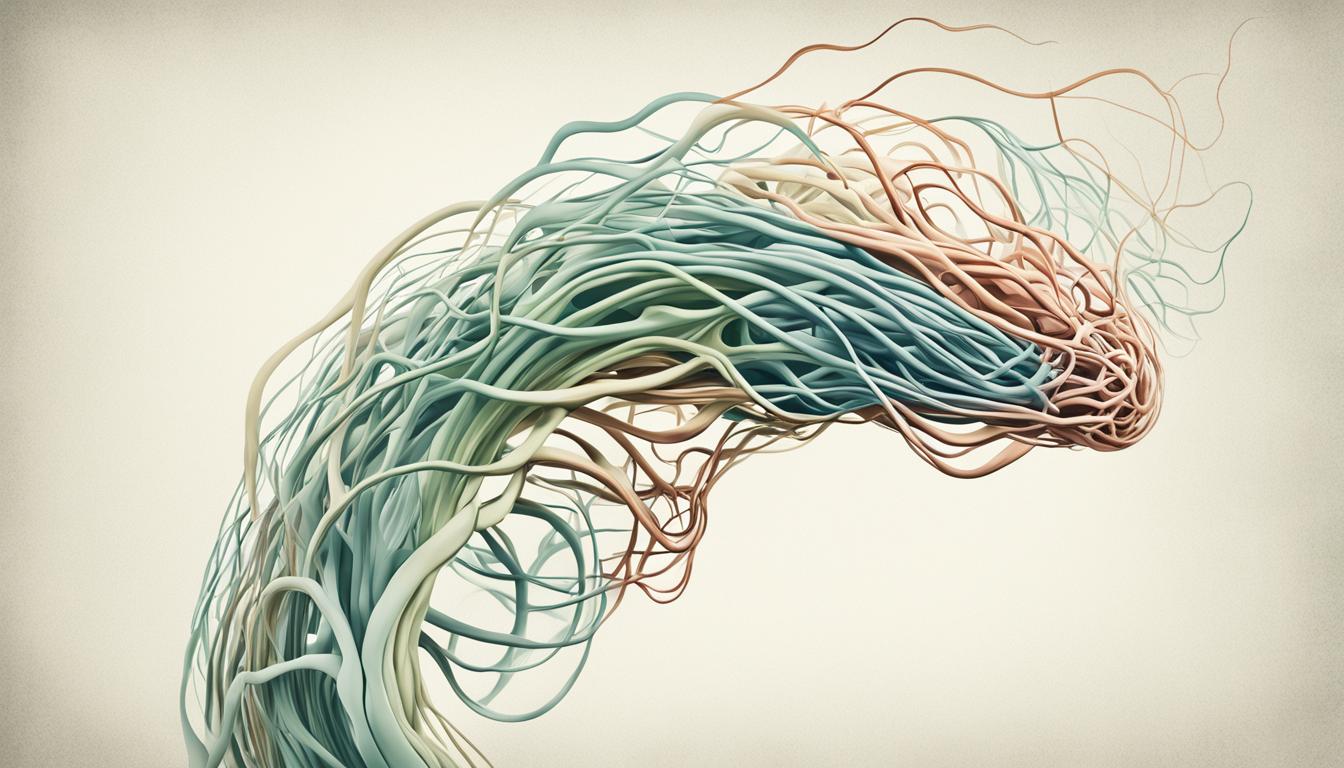Cervical dystonia is a rare disorder affecting the neck’s muscles. It leads to involuntary contractions. Thus, people’s necks might twist or turn in odd ways. These include turning the chin to a shoulder or tipping the head forward or backward.
Symptoms can get worse with stress or certain positions. Yet, sometimes they get better briefly by using tricks like touching the cheek. This illness can bring a lot of pain and make it hard to do regular activities. In the U.S., about 60,000 people are dealing with it.
What causes this condition still isn’t completely clear. However, it might be linked to certain genes. Scientists are working hard to figure out how this disorder works. They’re looking to create better treatments.
Key Takeaways:
- Cervical dystonia is a rare neurological disorder characterized by involuntary muscle contractions in the neck.
- The most common abnormal posture in cervical dystonia is twisting the chin toward a shoulder (torticollis).
- Other abnormal postures include head tipping forward, leaning backward, or tilting to one side.
- Symptoms may worsen with stress or certain postures but can temporarily improve with sensory tricks.
- Cervical dystonia can cause significant pain and disability, affecting the daily lives of those affected.
- About 60,000 people in the United States are estimated to have cervical dystonia.
- The exact cause of cervical dystonia is unknown, but a genetic susceptibility may play a role.
Diagnosis and Treatment Options for Cervical Dystonia
Diagnosing cervical dystonia involves a detailed checkup and studying the patient’s past. It’s important to rule out other causes. Tests like an MRI might be done to make sure it’s not something else.
Doctors mainly look at the symptoms to diagnose cervical dystonia. They check muscle movements, any pain felt, and how the neck moves. Skilled healthcare providers need to recognize these signs to diagnose it correctly.
Talking about your medical history is also key. Sharing past diagnoses, treatments, and what makes the symptoms better or worse helps. This information guides diagnosis and treatment choices.
Working together is vital in diagnosing cervical dystonia. The patient’s description of symptoms is crucial.
Treatment Options
There is no cure for cervical dystonia, but treatments help manage symptoms. The best option is based on the symptoms, the patient’s choice, and the doctor’s advice.
Botox injections are a common treatment. They weaken the muscles to reduce spasms. This treatment needs to be redone every few months.
Other treatments include medications, therapy, and surgery. The right approach is decided after talking with a healthcare provider.
To sum up, diagnosing cervical dystonia needs a close look at symptoms and history. Treatments like Botox, medicines, therapy, and surgery are available. If you think you have cervical dystonia, see a doctor for a proper check and treatment plan.
| Treatment Options | Description |
|---|---|
| Botox Injections | Makes muscles weak or paralyzed, helping with abnormal movements and postures. |
| Oral Medications | Help control muscle spasms and reduce symptoms. |
| Physical Therapy | Aims to better neck movement, posture, and reduce pain. |
| Surgical Interventions | Done if other options haven’t worked well enough, in severe cases. |
Stem Cell Therapy for Cervical Dystonia
Stem cell therapy is a new way to treat people with cervical dystonia. This is a health issue where muscles in the neck move without control. Stem cells can become different types of cells, which make them great for fixing and regrowing damaged tissues.
This treatment puts stem cells right into the muscle areas causing problems. The goal is to help those muscles heal and work better. Although still researching, early signs show stem cell therapy might make a difference for some.
The outlook is bright as stem cell research moves forward. This method could offer more help for those facing cervical dystonia. It’s not a magic cure, but it has the potential to make life better by easing symptoms and improving movement.
Yet, remember, using stem cells like this is still being tested. We need to know more about how well it works and how safe it is. If interested, talking with a doctor and joining clinical trials could go a long way in helping further develop this treatment.
FAQ
Q: What is cervical dystonia?
A: Cervical dystonia is a disorder that makes neck muscles contract involuntarily. This causes the head to move in unusual ways.
Q: What are the common symptoms of cervical dystonia?
A: The main symptom is the head twisting towards the shoulder. It can also cause the head to tip forward, tilt backward, or lean to one side.
This might get worse with stress or certain positions.
Q: How is cervical dystonia diagnosed?
A: Doctors diagnose cervical dystonia through a detailed medical exam and talking about the patient’s history. They also rule out other possible conditions. MRI scans can help here too.
Q: What causes cervical dystonia?
A: The exact cause is not clear. But, experts think some people may have a genetic risk for it.
Q: What treatment options are available for cervical dystonia?
A: Botox is a common treatment. It’s injected into the affected muscles to stop the nerve signals that cause the contractions.
Other options are physical therapy, drugs, and surgery, depending on the case.
Q: What is stem cell therapy for cervical dystonia?
A: Stem cell therapy is an up-and-coming treatment. It involves injecting stem cells into the muscles to help them heal and regenerate.
It’s still under research but might help some people.
Q: Where can I find cervical dystonia support?
A: You can find support at various groups and organizations. They offer info, resources, and a community for those with cervical dystonia.
Groups like the Dystonia Foundation and the Dystonia Medical Research Foundation are good places to start.

